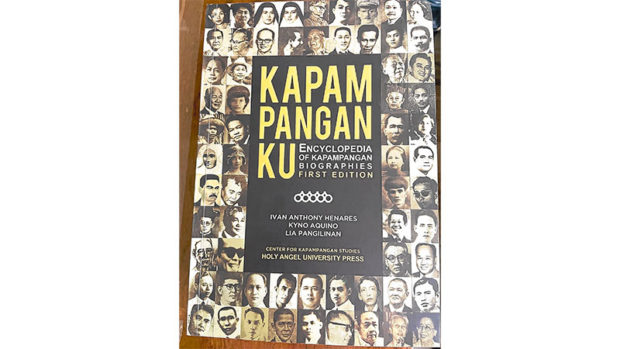
PROUD PEOPLE The first edition of “Kapampangan Ku” is launched in time for the 20th anniversary of Holy Angel University’s Center for Kapampangan Studies. —TONETTE OREJAS
ANGELES CITY, Pampanga, Philippines — It was not entirely idle for the Holy Angel University’s Center for Kapampangan Studies (CKS) during the pandemic.
It used the downtime to complete and publish the first edition of “Kapampangan Ku,” an encyclopedia of biographies, launching it on March 8 in time for the 20th year of CKS.
“We started writing the biographies long before the pandemic, and we were set to publish the book when the pandemic struck in March 2020, so we shelved the project,” Robby Tantingco, CKS director, told the Inquirer in an interview on Tuesday.
But he said they continued updating the book during the lockdown, and “when things got better, we decided to launch it finally.”
Spread over 286 pages were 1,663 biographies put together by writers Ivan Anthony Henares, Kyno Aquino and Lia Pangilinan.
“Memorable Kapampangans,” a special issue of the CKS magazine Singsing in 2003, was the seed of the project.
“While researching for this book, we were surprised at how widespread Kapampangans are. Who knew that another President of the Republic, Ramon Magsaysay, had Kapampangan blood? Or Communist Party of the Philippines founder Jose Ma. Sison, or Madrid socialite Isabel Preysler, or National Artist Fernando Poe Jr., or Broadway [star] Lea Salonga?” Tantingco wrote in the book’s foreword.
Basis for selection
He said selecting them this time was based on bloodline, their ability to speak the amanung sisuan (language) and their places of birth in the Kapampangan region (original geography of settlers along the Pampanga River).
Ancient or modern, Kapampangans in the first edition made local and national significance by way of their choices, actions and passions. A quick reading showed that several of them changed the country’s history and culture.
Tantingco said there were quite a number of discoveries that were difficult to ignore to be able to understand the Kapampangans.
A short entry revealed details about Malangsik: “Born to Prince Balagtas and Princess Panginoan, Malangsik and his kin organized a precolonial Kapampangan society. He became the ruler of the Kapampangan region from the 1400s until the 1500s. “
And there was Bambalito, the young chieftain from Macabebe who remains unrecognized as the first Filipino to die defending the country’s freedom in the Battle of Bankusay on May 24, 1571. The defeat led the Spaniards to make Pampanga their first province in Luzon seven months later on Dec. 11.
The anthology included the 78 Macabebe Scouts who, aside from capturing Emilio Aguinaldo in Isabela province, are praised for their military skills and blamed for the race’s trait of “dugong aso” (excessive loyalty).
It is a lesser-known fact that anger was triggered in them by the murder of 300 residents locked in the torching of Macabebe church by an Aguinaldo colonel.
The book, said Tantingco, is dedicated to those “who never forget and never deny—and in fact, always shout to the world—that they are Kapampangans.”
Some early readers said the anthology must be read by younger Kapampangans so they could draw inspiration from their forebears.
RELATED STORIES
First step to next 500 years of Christianity in PH starts in Pampanga
Rich Pampanga literature buried by Pinatubo’s wrath
Late Kapampangan poet John Manalili remembered with tributes at his wake